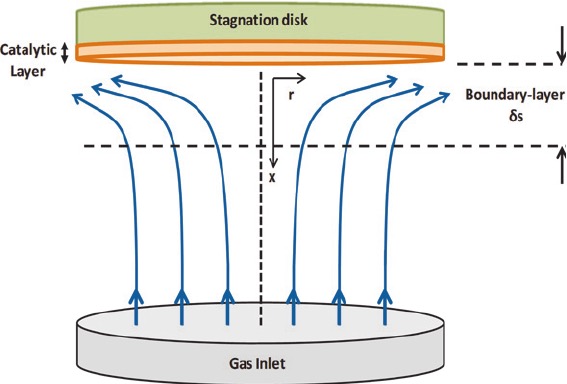DETCHEM Stagnation Driver
This document describes the configuration directives that are available for use with the DETCHEM Stagnation driver.
The DETCHEM Stagnation code simulates the steady state chemically reacting gas flow impinging onto a catalytic plate using the boundary layer approximation. Detailed mechanisms for surface and gas phase reactions are considered.

SI units are used exclusively throughout the program. Be sure to convert all values before importing data into CaRMeN. When referring to chemical species, use the correct capitalization, i.e. Ar instead of AR. Not doing so will lead to simulation errors since the species names will not be recognized.
Driver Name
This driver is available under the name detchem_stagnation.
Output Resources
This driver outputs two tabular data resources. Both contain data for the steady state solution.
mole_fractions- The axial concentration profile along the x-axis (see picture) in mole fractions.coverages- The surface coverages on the disc in mole fractions.
Parameters
The following parameters are available.
# The distance between the gas inlet and the surface (in this example: 3.9cm)
distance_inlet_disk: 3.9e-2 # m
# The pressure in the reactor (in this example: 0.5bar)
pressure: 0.5e5 # Pa
# An object that defines the conditions of the gas flow entering the reactor,
# i.e. initial conditions
inlet:
temperature: 429 # K
gas_velocity: 0.71 # m/s
# The composition of the gas entering the reactor
mole_fractions:
CH4: 0.05163
H2O: 0.053796
# An asterisk can be used to denote the remainder to unity. It must be enclosed in quotes!
Ar: "*"
# An object that describes the properties of the disk surface
surface:
temperature: 1008 # K
# The ratio of catalytically active surface area and geometrical surface area.
f_cat_geo: 16 # dimensionless
# A complex object type describing the chemical model.
# Use the chemical-model loader to produce a resource with the correct structure,
# then access it using the $resource macro as shown here.
chemical_model:
$resource: ./chemical_model
#
# Optional parameters follow below.
# The given values are the default values used when the parameter is omitted.
#
# The time to integrate to. Should be sufficiently high to reach steady state.
integration_time: 100.0 # s
# A boolean to indicate whether the surface temperature is to be kept constant or not.
constant_surface_temperature: true
# Whether to take the thermal diffusion effect into account.
thermal_diffusion_effect: false
# An object describing the properties of the washcoat. Currently, only the effectiveness model
# is supported. Please file a feature request at https://gitlab.com/carmenjs/carmen/issues
# if you also need detailed washcoat models. The default is not to consider a washcoat model.
# Although the washcoat key itself is optional, the properties within the washcoat are not.
washcoat:
thickness: 4e-5 # m
pore_diameter: 1e-8 # m
tortuosity: 3 # dimensionless
porosity: 0.6 # dimensionless
# A list of diffusion limiting species used in the effectiveness factor model.
diffusion_limiting_species:
- CH4
- H2O
grid:
# An integer that specifies the number of axial grid points.
# Can be used to work around numerical issues.
number_points: 60
# Controls the spacing between the grid points.
aspect_ratio: 1.0
# Settings pertaining to the numerical solution.
solver:
absolute_tolerance: 1e-10
relative_tolerance: 1e-4
initial_integration_step_size: 1e-12
max_integration_step_size: 1
# Settings for the solution of chemical source terms of surface reactions
chem_surf:
initial_integration_step_size: 1e-10
integration_time: 10.0
max_integration_step_size: 1.0
absolute_tolerance: 1e-20
relative_tolerance: 1e-6